The Friends of the Wildflower Garden, Inc.
Invasive Plants in Minnesota
The Eloise Butler Wildflower Garden is the oldest public wildflower garden in the United States
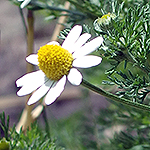
Common Name
Dog Fennel (Mayweed, Stinking Chamomile, Stinking Cotula, Fetid Chamomile, Dog's Chamomile)
Scientific Name
Anthemis cotula L.
Plant Family
Aster (Asteraceae)
Garden Location
No longer extant in the Garden
Prime Season
Late Spring to early Autumn Flowering
Dog Fennel is an introduced erect annual forb growing from 4 to 36 inches high on much branched stems and usually with a fetid odor and acrid taste. Stems are mostly green, sometimes with red tinges as seen below; varying from free of hair to with many short stiff hairs - sometimes glandular in the upper stem.
The leaves are alternate on the stem and pinnately divided 1 to 2 times (sometimes 3x) into narrow pointed lobes which are very thin, without hair, and stalkless in the upper stem, stalked on the lower stem. Leaves are 3/4 to 2-1/2 inches long. A foul odor is released when leaves are crushed.
The floral array is a solitary, stalked flower at the end of the stem branches, stalks up to 4 inches long.
The flower head involucre is 5 to 9 mm in diameter and the head when open is up to 1-1/4 inches wide. It is convex on top initially and then becomes oblong forming a small dome of disc florets. The head is composite with two floret types. An outer ring of 10 to 15 ray florets with white rays. Ray tips are rounded but most will show 3 teeth. These florets bear styles but are sterile. The ray florets surround a central receptacle of numerous (100+) disc florets which have yellow corollas and are bisexual and fertile. Corolla tubes are cylindric with 5 stamens tightly surrounding the central style of each floret. The outer disc florets have a very small bract. Wrapping the outside of the flower head are 3 to 5 series of green phyllaries which have whitish margins and are densely hairy.
Seed: Fertilized disc florets produce a dry brown cypsela, 1.3 to 2 mm long, with 9 to 10 ribs, often gland dotted in the rib furrows. They are without any bristly or fluffy pappus and are distributed by the wind shaking the stem and by water as the seeds are light enough to float easily. Each plant can produce thousands (up to 960,000 on large plants) of seeds which remain viable in soil for a number of years. (Ref. at bottom of text below photos). The plant spread widely in earlier times as the small seeds were frequently found as an impurity in grass and clover seed. (Ref. #6b)
Habitat: Dog Fennel sets down a taproot with many fibrous roots in disturbed sites with various types of soil, thrives in rich soils, in mostly moist conditions or where there is regular moisture applied, full sun preferred. It used to be prevalent in barn yards. In the western states it is often found in irrigated fields. It spreads by re-seeding. (Ref. Below)
Names: In older literature Dog Fennel was classified as Maruta cotula. The genus name Anthemis, refers to Chamomile and is from the Greek name anthĕmis for that plant. The species cotula, means 'small cup' in Greek and may refer to the hemisphereic shape of the flower head. The author name for the plant classification - 'L.' refers to Carl Linnaeus (1707-1778), Swedish botanist and the developer of the binomial nomenclature of modern taxonomy. The use of the word fennel is due to the leaf resembling that of fennel, and 'dog fennel' then refers to a fennel-like plant with the foul odor, perhaps like certain wet dogs. See Eloise Butler's notes below the photos.
Comparisons: The most similar species is Anthemis arvensis, Corn Chamomile which looks very similar but the stems branch mostly in the lower section, not throughout, and the foliage does not have the fetid odor when crushed. The plant also resembles the true chamomile, A. nobilis, but that plant lacks the odor and the flowers have membraneous scales beneath and is not found in the wild in North America.
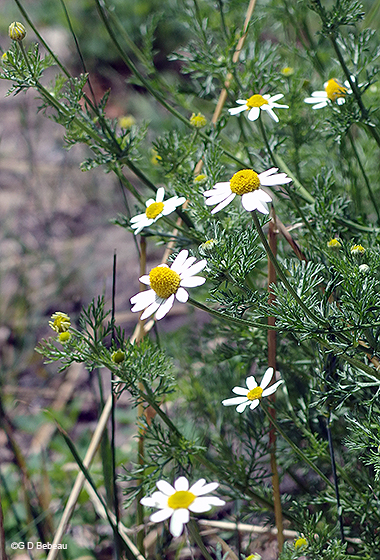
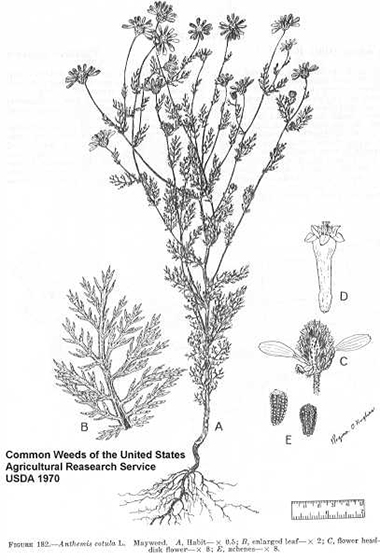
Above: The floral array is a solitary stalked flower at the end of stem branches. Drawing courtesy USDA-NRCS Plants Database.
Below: The composite flowerheads have only 10 to 15 non-fertile ray florets but hundreds of small fertile disc florets.

Below: 1st photo - The phyllaries of the flowerhead are in several series, green center rib and whitish margins, all densely hairy. 2nd photo - The small leaves are up to 2x pinnate with narrow lobes.

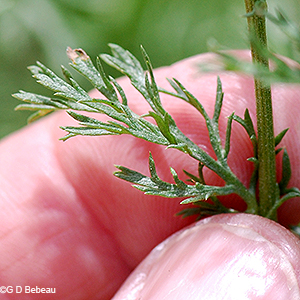
Below: 1st photo - A leaf cluster with flower bud developing - note the reddish tinge on the stem. 2nd photo - leaves on the upper stem are stalkless. The stem is ridged with short hairs.


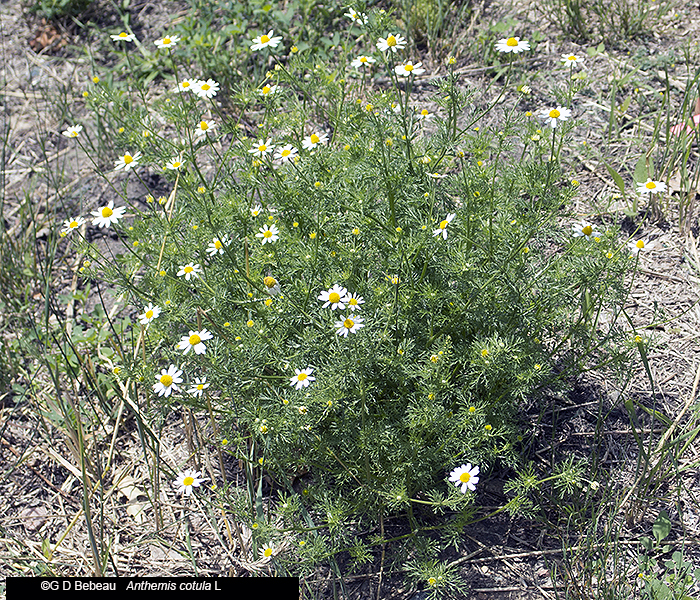
Notes: Dog Fennel was introduced to the Garden in August 1949 by Curator Martha Crone. It is a widely distributed weedy plant, found in Europe, Asia, Africa, Australia and now naturalized in all of North America except the far north Canadian Provinces. While there are around 175 species of Anthemis world-wide, only two are found in North America, the other being A. arvensis, Corn Chamomile. Within Minnesota Dog Fennel is found in less than half of the counties, but they are widely located throughout the State and is the only species of Anthemis in the state. It is not known how long Dog Fennel continued to exist in the Wildflower Garden.
Eloise Butler wrote of Dog Fennel: "A vegetable pariah, also of foreign origin, humbly occupying waste places, is especially abundant about drains and pig sties, and is stigmatized by the rude Saxon term, “stinkweed”. It is also known as Dog Fennel and as May Weed, although it blooms throughout the summer until nipped by frost. It is as pretty as its much admired cousin, “Marguerite” - cultivated here, but an injury to the hay fields in the East - for it has the daisy beauties of pearly white ray flowers encompassing golden tubular flowers of the disk." By “Marguerite” - she is referring to the Oxeye Daisy, Leucanthemum vulgare Lam., which has a similar flower arrangement. The old French name for that flower, “Marguerite,” is from the petal pulling game of "He loves me, he loves me not" ('effeuiller la marguerite' in the French).
"The leaf too, may be favorably compared with that of the fern. But the weed is without regard on account of its associations and fetid odor. It bears the scientific name Maruta cotula, and its nearest kin are the garden and medicinal chamomiles." Her comments were published on Aug. 27, 1911 in the Minneapolis Sunday Tribune. Read entire article.
Toxicity: Dog Fennel has been found to cause skin rashes and to irritations such as mouth and nose blistering to grazing animals. Dairy cattle who eat it will have milk with a strong off-flavor (Ref. below). As to the caustic properties of handling the plant, when it frequently grew among farm cereal plants and was collected with the desired plants, Englishman Thomas Tusser wrote 450 years ago that "The Mayweed doth burn and the Thistle doth fret."
Other references: Information relating to agriculture is from The University of Nevada and the Colorado Weed Management Association.
Return to -- Site Plan/Archive Index --or-- List of Common Plant Names -- or -- List of Scientific Names -- or --Home Page - - - Back to top.
References: Plant characteristics are generally from sources 1A, 32, W2, W3, W7 & W8 plus others as specifically applied. Distribution principally from W1, W2 and 28C. Planting history generally from 1, 4 & 4a. Other sources by specific reference. See Reference List for details.
 Identification booklet for most of the flowering forbs and small flowering shrubs of the Eloise Butler Wildflower Garden. Details Here.
Identification booklet for most of the flowering forbs and small flowering shrubs of the Eloise Butler Wildflower Garden. Details Here.
©2016
Friends of the Wildflower Garden, Inc. Text and photos are by G. D. Bebeau unless otherwise credited. "www.friendsofeloisebutler.org"
051622